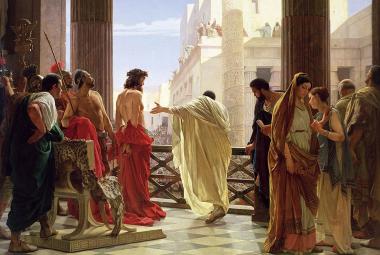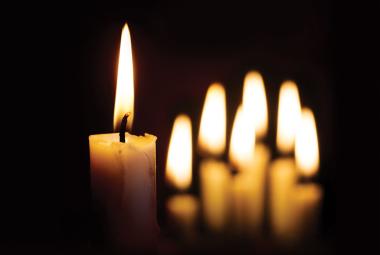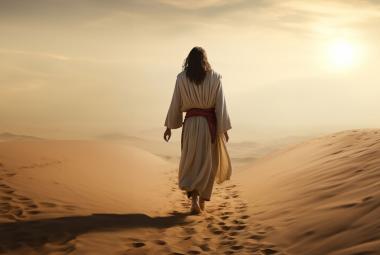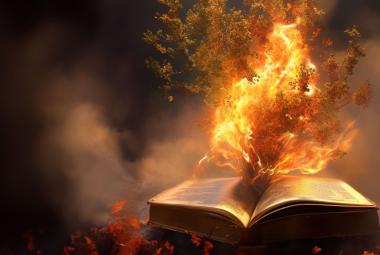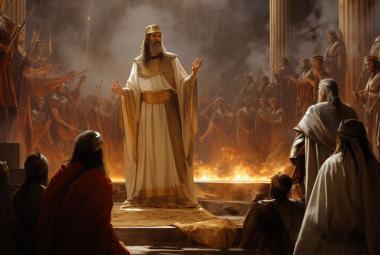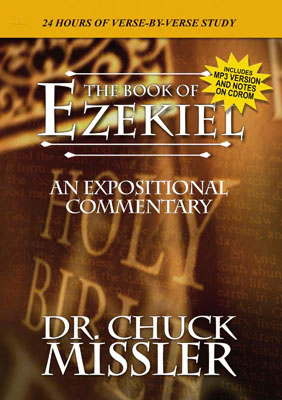With the new CD-ROM release this month of our commentary on the Book of Ezekiel it seems like an appropriate time to profile this most fascinating prophet of the Old Testament.
In fact, with the current geopolitical horizon, you can't really understand the caldron of the Middle East unless you understand the remarkable prophecies in this book.
Ezekiel was among the captives with King Jehoiachin in the second of three deportations under King Nebuchadnezzar of Babylon. He mentions Daniel three times, who had been in Babylon nine years before Ezekiel arrived.
Ezekiel ministered, as did Jeremiah, to a nation experiencing judgment for their sins. (If God spared not Israel, His Chosen, when they sinned, why not America?)
In his captivity he lived at the River Chebar, which was the great ship canal branching off from the Euphrates above Babylon and turning through Nippur to the Tigris. This was the primary settlement location of the Jewish captives.
Ezekiel was born in approximately 627 B.C. and lived in a time of moral decline, distress and uprooting. His messages were not well received at first, but did ultimately result in the nation being purged of idolatrous practices. He was married and owned his home. His wife died during his ministry, and he was forbidden to mourn her.
We also learn that God intended his life to be a series of signs to Israel; therefore, he does all kinds of strange things. (This was before Christian television.)
He shuts himself up in his home. He binds himself. He is struck dumb. In a formal ritual, he was to lie on his right and his left sides for a total of 430 days. He ate bread that was prepared in an unclean manner. He shaved his head and beard, which was considered a shame in his particular calling.
Throughout the book, his main theme was the sovereignty and glory of God. This is good for us, because we can get so focused on God's grace that we tend to forget there is also a governing role of God, and that His glory requires justice.
Ezekiel was very direct. He carefully vindicated God's justice throughout the book, although he deals more in symbol and allegory that any other Old Testament prophet.
He is probably the greatest mystic of the Old Testament. He was well suited for the calling God gave him, which included a remarkable vision of God's Throne in Chapter 1. This dramatic vision of God never left him. It is not just introduced in the first chapter, it is referenced all the way through.
The Prophet of the Regathering
The famed vision of the Valley of the Dry Bones in Chapters 36 and 37 is not only the subject of the well-known Spiritual chorus, it is unquestionably the monumental Biblical fulfillment of the 20th century.
Beginning in the last half of the 19th century, the regathering that climaxed in the establishment of the State of Israel is one of the most irrefutable evidences that we are on threshold of God's climax for the nations mentioned throughout the Bible - and remarkably detailed in the writings of Ezekiel.
(There is even a possible chronological hint hidden in Chapter 4 which would seem to identify the re-establishment of the nation of Israel on May 14, 1948, and the regaining of the city of Jerusalem on June 6, 1967.)
The Millennium Temple
The final chapters, 40-48, climax with a remarkably detailed description of the Millennial Temple to be rebuilt. Ezekiel was uniquely qualified for this role due to his priestly background.
He was the son of Buzi, who was also a priest. It is interesting that even though he never served as a priest, he apparently so influenced later worship that today he is called by some, "The Father of Judaism."
From Numbers 4:3 we know that Kohathites had to be 30 years old before they could begin service as priests. When Ezekiel became 30, however, he was deported, in approximately the eightieth year of the reign of Nebuchadnezzar.
The Temple which Ezekiel describes has never yet been built. Most scholars regard it as the details for the Temple which will be established during the Millennium on Planet Earth.
Between the regathering of the nation in Chapters 36 and 37, and the Millennium Temple described in Chapters 40-48, there is a climactic event that intervenes.
The Intervening Event: Gog and Magog
The invasion of Gog and Magog, described in Chapters 38 and 39, are among the most famous prophetic passages in the Bible. For a variety of reasons, the identity of "Magog" as the people of Russia seems well established.
One reason to study the Book of Ezekiel is that, from current updates by leading intelligence sources, the decision to invade the Middle East seems to have been already made in the Kremlin, and it is now only a matter of timing.
Almost all the details described by Ezekiel are currently being set in place for this climactic event, which we feel is post-Rapture!
The Opportunity
If you were invited to a reception that would bring you into contact with a world-famous author, you would, of course, run out and quickly review his book to avoid any embarrassment.
Well, you may soon be in the company of one of the most fascinating characters of the Old Testament, and when you are introduced to him, you will want to be able to declare, "Hey, I sure enjoyed your book!"
Have you ever studied this incredible book carefully? See our Expositional Commentary on Ezekiel, now on CD-ROM, with MP3 audio files (and the necessary software) and also the PDF text files (again, with the necessary software).

